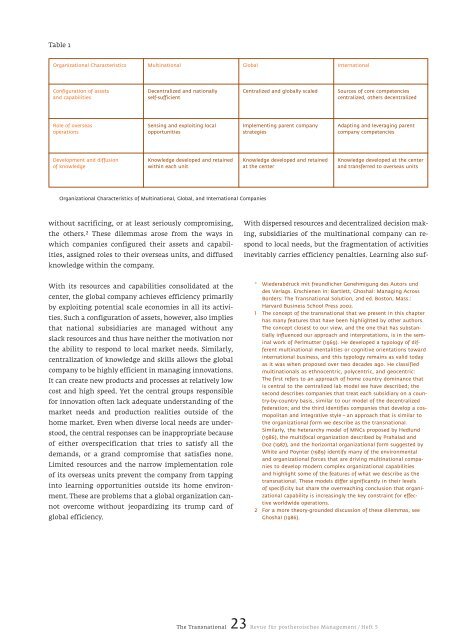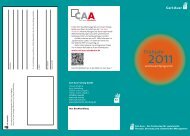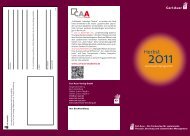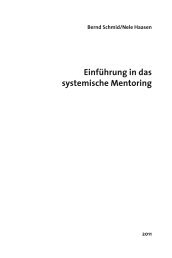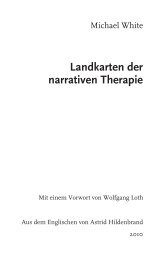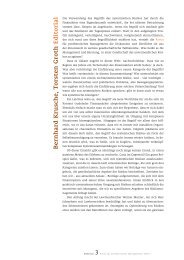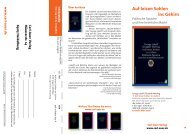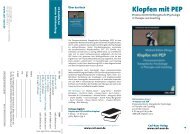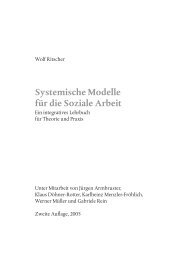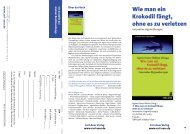K a trin G la tz e l E d ito ria l
K a trin G la tz e l E d ito ria l
K a trin G la tz e l E d ito ria l
Sie wollen auch ein ePaper? Erhöhen Sie die Reichweite Ihrer Titel.
YUMPU macht aus Druck-PDFs automatisch weboptimierte ePaper, die Google liebt.
Table 1<br />
Organizational Characteristics<br />
Configuration of assets<br />
and capabilities<br />
Role of overseas<br />
operations<br />
Development and diffusion<br />
of knowledge<br />
without sacrificing, or at least seriously compromising,<br />
the others. 2 These dilemmas arose from the ways in<br />
which companies configured their assets and capabilities,<br />
assigned roles to their overseas units, and diffused<br />
knowledge within the company.<br />
With its resources and capabilities consolidated at the<br />
center, the global company achieves efficiency primarily<br />
by exploiting potential scale economies in all its activities.<br />
Such a configuration of assets, however, also implies<br />
that national subsidiaries are managed without any<br />
s<strong>la</strong>ck resources and thus have neither the motivation nor<br />
the ability to respond to local market needs. Simi<strong>la</strong>rly,<br />
centralization of knowledge and skills allows the global<br />
company to be highly efficient in managing innovations.<br />
It can create new products and processes at re<strong>la</strong>tively low<br />
cost and high speed. Yet the central groups responsible<br />
for innovation often <strong>la</strong>ck adequate understanding of the<br />
market needs and production realities outside of the<br />
home market. Even when diverse local needs are under-<br />
stood, the central responses can be inapprop<strong>ria</strong>te because<br />
of either overspecification that tries to satisfy all the<br />
demands, or a grand compromise that satisfies none.<br />
Limited resources and the narrow implementation role<br />
of its overseas units prevent the company from tapping<br />
into learning opportunities outside its home environ-<br />
ment. These are problems that a global organization can-<br />
not overcome without jeopardizing its trump card of<br />
global efficiency.<br />
Multinational Global International<br />
Decentralized and nationally<br />
self-sufficient<br />
Sensing and exploiting local<br />
opportunities<br />
Knowledge developed and retained<br />
within each unit<br />
Organizational Characteristics of Multinational, Global, and International Companies<br />
Centralized and globally scaled Sources of core competencies<br />
centralized, others decentralized<br />
Implementing parent company<br />
strategies<br />
Knowledge developed and retained<br />
at the center<br />
Adapting and leveraging parent<br />
company competencies<br />
With dispersed resources and decentralized decision making,<br />
subsidiaries of the multinational company can respond<br />
to local needs, but the fragmentation of activities<br />
inevitably carries efficiency penalties. Learning also suf-<br />
The Transnational 23 Revue für postheroisches Management / Heft 5<br />
Knowledge developed at the center<br />
and transferred to overseas units<br />
* Wiederabdruck mit freundlicher Genehmigung des Autors und<br />
des Ver<strong>la</strong>gs. Erschienen in: Bartlett, Ghoshal: Managing Across<br />
Borders: The Transnational Solution, 2nd ed. Boston, Mass.:<br />
Harvard Business School Press 2002.<br />
1 The concept of the transnational that we present in this chapter<br />
has many features that have been highlighted by other authors.<br />
The concept closest to our view, and the one that has substantially<br />
influenced our approach and interpretations, is in the seminal<br />
work of Perlmutter (1969). He developed a typology of different<br />
multinational mentalities or cognitive orientations toward<br />
international business, and this typology remains as valid today<br />
as it was when proposed over two decades ago. He c<strong>la</strong>ssified<br />
multinationals as ethnocentric, polycentric, and geocentric:<br />
The first refers to an approach of home country dominance that<br />
is central to the centralized <strong>la</strong>b model we have described; the<br />
second describes companies that treat each subsidiary on a country-by-country<br />
basis, simi<strong>la</strong>r to our model of the decentralized<br />
federation; and the third identifies companies that develop a cosmopolitan<br />
and integrative style – an approach that is simi<strong>la</strong>r to<br />
the organizational form we describe as the transnational.<br />
Simi<strong>la</strong>rly, the heterarchy model of MNCs proposed by Hedlund<br />
(1986), the multifocal organization described by Praha<strong>la</strong>d and<br />
Doz (1987), and the horizontal organizational form suggested by<br />
White and Poynter (1989) identify many of the environmental<br />
and organizational forces that are driving multinational companies<br />
to develop modern complex organizational capabilities<br />
and highlight some of the features of what we describe as the<br />
transnational. These models differ significantly in their levels<br />
of specificity but share the overreaching conclusion that organizational<br />
capability is increasingly the key constraint for effective<br />
worldwide operations.<br />
2 For a more theory-grounded discussion of these dilemmas, see<br />
Ghoshal (1986).


